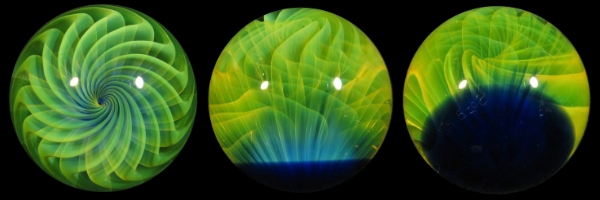
My Marble Journey |
As mentioned on the "about" page, Contemporary Art Glass Marbles have been my main vehicle in charting the possibilities and limits of borosilicate glass. Each marble is an experiment that broadens my understanding and presents new directions to pursue.
Looking back after more than a decade, my work has undergone several distinct stages of evolution that are interesting to ponder. This page seeks to offer a general synopsis of these stages as well as a little background information that might expand that appreciation.
Small developments are happening constantly in the studio, and I intend to chart these as they occur in an ongoing blog, which I will link here when it is up and running.
A note on marble names:
From an early point I've always named my marbles. This has a practical point in that it provides an easy reference for a particular piece outside of boring schemes such as numbering, but more importantly it has a deep artistic appeal, seeking to capture a vibe or impression about what the marble *speaks*, at least to me. I name both marble series and the individual marbles. It's great fun, and it's like the final seal on a piece.
~The Emeralds~
This series represents my starting point in seeking to master the technique of tube implosion. The Emeralds typically consist of a single spiral fumed implosion.
"Fuming" refers to a process wherein pure gold and silver are smoked or "fumed" onto the surface of the glass. This results in a thin haze that is then captured by laying lines or dots of clear glass; any fume that is not captured, or "encased" in clear will burn off as the piece is finished. Once this is done and the tube is imploded I give the Emeralds a backing or "coin" of cobalt blue, which by providing a dark background enables the full expression of the ghostly coloring of the fumed lines.
Working through this series led to realizations that would inform all further inquiries, such as the virtue of filling an entire sphere from surface to surface with an imploded form (as opposed to having large areas entirely clear, which could be called "claiming the canvas"), and the understanding that a sphere should ideally be presentable from every angle (as opposed to having a "front" and a less entrancing "back").
I still make these marbles from time to time, often as gifts for friends at notable life milestones; they are always available upon request.
Click on any image below for more examples of each style
 |
Next I set out to see what I could do with the wonderful palette of borosilicate color rods, and thereby chart the colors' various subtleties and particularities.
This effort eventually stabilized as the "Whorl To Come" series, consisting of an elaborate single implosion without backing or surface work of any kind. The goal was to make a symmetrical abstract form floating in a sphere of clear glass, a form equally pleasing or "gazeable" from any angle.
These began with a sort of double-twist, so that both the top face and the bottom point were spiralled (as can be seen on the examples page below), but as they developed I discovered a way that could deliver a spiral core backed with straight radial lines, and they took this form for the duration. As a general fan of polar opposites held in balance, I found the contrast of round-to- straight to be one of the WTC's fine points.
Another aspect that developed as the series progressed was that of translucence. I began with forms that were more or less opaque, yet as I went on I found myself leaning more and more toward using translucent colors. I came to the conclusion that not only is it virtuous to have a marble presentable from all angles, but also to have the forms themselves (i.e. the various stripes of color inside the marble) translucent enough to allow light to permeate and to peer through forms, to other forms. This virtue is sometimes called "multilayer magnificence", and can be enough to cause a gazer momentary dizzyness.
The name "Whorl To Come" is a playful distortion of the "World To Come" of the Book of Splendors, the classic of Jewish mysticism. I called it this because I had a sense all along that this form was a seed-form that would become the base of all future marble efforts.
This is a closed series, but I'm occasionally open to special requests for approximations.
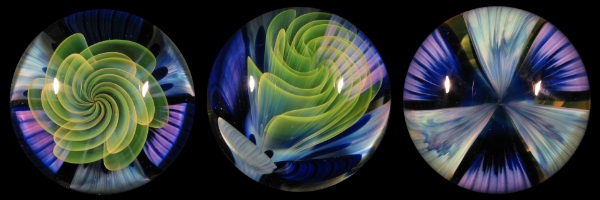 |
The Whorl To Come series saw many interesting variations, with the most notable being those of the sub-series "Vortexia Perplexia". These were essentially a Whorl To Come but with a vortex core instead of a spiral, and thus typically had the same straight-lobe backing as the WTC.
These marbles differ from most vortex-style marbles in which the center "vortex" is a solid cone and the backside is covered in opaque color. As implosions, The VP's are vortexes that are composed of many independent forms all working together to form the well, enabling the gazer to peer at the entire creature from every angle.
Vortexia Perplexia is also a closed series, but I sometimes make requests.
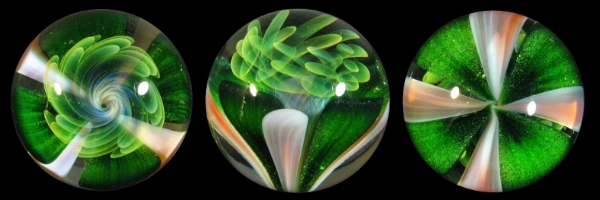 |
As the Whorls reached their height I began to ponder pushing past the single-implosion paradigm and find out what I could do with component marbles, or marbles made with two or more sections that are then joined into a single marble. The first stop on this tour was a simple double style that I termed the "Intel-Diplo" series.
The central virtue that I found in this series was that of Chaos. Symmetry was the main virtue in all previous series; the Intel-Diplo, with its impression of smoke-caught-in-a-ball, was a pleasing departure from rational forms that has heavily influenced all of my work since.
The term "Intel-Diplo" is a reference to the late great Peter Tosh, who is said to be the "intelligent diplomat" of God, though I use the term more functionally to refer to a carefully designed (Intel) double-sided (Diplo) marble.
This series in retrospect was more like a quick stop on the way, and to date I haven't made very many; I'd say there are no more than 20 in the world.
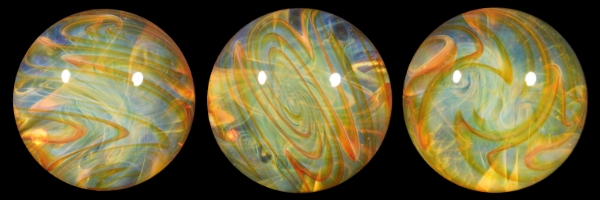 |
The Intel-Diplo got me thinking about other ways to incorporate multiple sections into a piece; this led me into a series of marbles that illustrated so many possiblities that it would clog my senses. It became a completely new way of thinking about marbles, and the effort to simply narrow it down to design the next marble required extensive pondering and very careful planning. This effort became tentatively known as the "Compendi Confundus" series; I thought of it as a "compendium" of everything I'd done sofar, and was "confounding" for the reason stated above.
This effort was more than ever a process of discovery that produced unexpected results. One of the more notable of these results was that I started to make all of them in two main parts of differing size. This appears as a two-sided marble with one side bigger than the other, what I call the "major and minor" sides. I found that the proportional difference of these sides somehow suggested dynamic motion, like the slight forward-lean required when walking. It's a willful imbalance that results in motion, and if the two sides are equal it suggests stasis.
It was the settling on this form of major/minor that inspired me to re-name the series "Threshold", both to suggest that division like two areas seperated by a door, and to indicate that I felt it was a breakthrough point that would lead to many strange wonders.
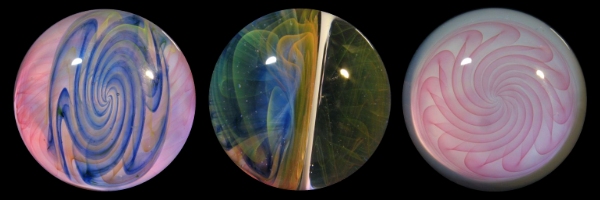 |
The Eyeball Revolution
I never really set out to make eyeball marbles, Rather I found myself there suddenly.
In the pursuit of interesting new inclusions for the Threshold series I stumbled into a technique that resulted in a circular-radial form like a spoked wheel, and it occurred to me that it might serve well as a way to make a deeply patterned and realistic iris.
To express this I made my version of a basic eyeball marble with an iris on a white, although I modeled the white after the swirling forms of the Intel-Diplo; I saw this approach as kind of a dichotomy or agreement between realism (the iris) and surrealism (the spiralled and veined white).
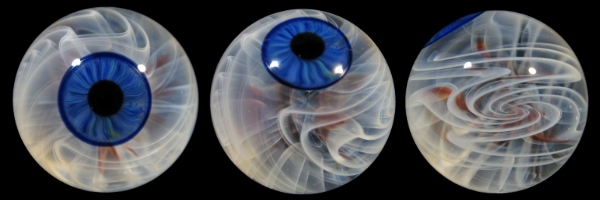 |
The more I made these eyeballs the more I enjoyed the iris as a form; a great variation of textures was possible, and they gave an eerie presence or consciousness to the marble that I found irresistable.
I set out to take them completely surreal and incorporate everything I'd learned about color and texture from the Whorl To Come series, perhaps inspired a bit by Warhol's multicolored pop art photo montages with Marilyn Monroe and others. A line of these marbles would have a similar effect, repetitions of same form expressed in wildly and playfully varying hues.
As this series began to unfold I realized that it was a true merging of all of my various series and sub-series of marbles, and thus the series needs no name; these are living beings that speak for themselves.
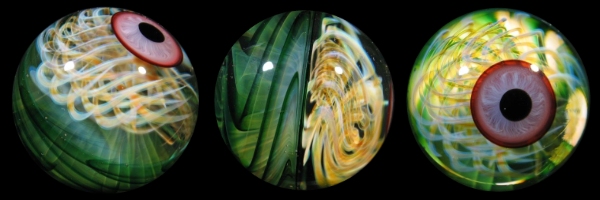 |
As of this writing the Eyeballs continue to grow and evolve, ever showing me new and strange things. They teach me the subtleties of proportion and the hidden rules of color complementary. They challenge me to delve deeper into the mysteries of implosion and encalmo. Every time they test the limits of my skill in keeping the iris symmetrical enough to be lifelike. All of these things feel like they grow my glass brain and prepare it to reach new, unimagined heights.
Though the rules have all been abolished they still tend to settle into certain forms, such as the chaotic-major-stable-minor-style and the Swirler (twisted) form. New ground has been broken in the encalmo layer as well; The best of these can be seen in the marble gallery that I strive to keep current.
I'd like to blog more on marble evolvements as they happen and set it as a goal; if you like what you've read here check back and time-willing I can make that happen as well.
| back | home | contact |